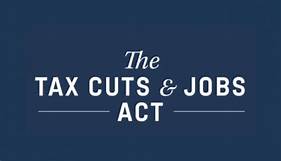What Restaurant Businesses Need to Know About Tax Cut and Job Act Benefits
- November 8, 2019
- Posted by: flores
- Category: flores blog

What Restaurant Businesses Need to Know About Tax Cut and Job Act Benefits
by Marshall Varano, CPA, Partner at Cohn Reznick
The congressional rush to pass to tax reform legislation generated implementation questions, not only from taxpayers and tax professionals, but the IRS as well. Now that the 2018 filing season is behind us and new provisions are in effect, it’s a good time to evaluate how the Tax Cuts and Jobs Act (TCJA) will affect your restaurant business this year.
Identifying where changes did and did not occur
Although we’ll explore TCJA changes, two important areas did not change. The first is the Federal Insurance Contribution Act (FICA) tip credit, a federal tax credit related to the FICA taxes paid by the employer on declared employee tips. The second is the Work Opportunity Tax Credit, a significant but often overlooked federal tax credit relating to hiring certain types of qualified employees, such as veterans, people receiving government assistance, and former felons.
Bonus depreciation includes some cumbersome transition rules, but generally provides for 100% expensing of the cost of certain qualified property – generally furniture, fixtures, and equipment. This is an increase from the 50% bonus provision in the prior law. A new benefit of this change is that used property also qualifies for this provision.
Unfortunately, a technical glitch in the law has not yet been corrected. It does not allow this provision to be applied to qualified improvement property (QIP) placed in service after Jan. 1, 2018. QIP includes any improvement to the interior of a nonresidential building if the improvement is placed in service after the building was placed in service, and it generally excludes enlargement of the building, elevators, escalators, or internal structural framework. This type of property qualified for bonus depreciation under prior law, but Congress has not fixed its drafting error and consequently, the IRS is not allowing this benefit for now.
In another related change from prior law, such improvements must be depreciated over 39 years, instead of the previous 15 years.
There is some hope, though. IRC Section 179 was expanded to allow qualifying additions up to $1 million to be currently expensed and to include new qualifying items such as roofs and heating, ventilation and air-conditioning; and fire, alarm, and security systems. Special rules govern the availability of this deduction.
Understanding complexities of pass-through entity deductions
The IRC Section 199A pass-through entity deduction attempted to put pass-through entities on the same playing field as C corporations regarding the new lower C corporation tax rate of 21%. Since tax rates for individuals are higher than 21%, Section 199A provides a deduction for pass-through entity income roughly equal to the lesser of 20% of qualified business income or a limitation based on the greater of these two tests:
- 50% of the taxpayer’s pro rata share of W-2 wages paid by the entity, or
- The sum of 25% of the W-2 wages with respect to the business, plus 2.5% of the basis of qualified property.
Calculating and applying exceptions to this provision are complex processes but can benefit individual taxpayers.
Limitation Provisions
A new limitation of TCJA is the excess business loss rule. This rule limits the current deductibility of business losses in excess of $500,000 for a joint return. This means that if your restaurant generates a loss of $600,000 in the current year (possibly because of using bonus depreciation, as previously described), only $500,000 of that loss can be used in the current year to offset other sources of income such as wages, interest, dividends, and capital gains. There are exceptions to this rule that allow offset against business gains reported on Form 4797 and wages from the activity of being an employee. IRS Form 461 provides guidance for including wages in this calculation.
IRC Section 163(j) also limits an entity’s deductibility of interest expense to 30% of adjusted taxable income. The calculation is complicated and generally applies only if average gross receipts for the prior three years exceed $25 million or the entity is considered a tax shelter.
Small Taxpayer Benefits
Small taxpayers below the $25 million threshold mentioned above can access certain benefits by filing an Application for Automatic Change in Accounting Method, IRS Form 3115. These benefits include use of the cash method of accounting, exemption from the uniform capitalization rules, and, important for restaurants, being able to treat inventories as nonincidental materials and supplies (i.e., expensing inventory currently).
Other Items to Consider
Remember, if you have 50 or more full-time equivalent employees, the Affordable Care Act provisions still apply and the IRS is actively reviewing forms 1094-C and 1095-C for compliance violations and filing errors.
Sustainable practices: Managing food waste has been or should be a concern for all restaurants. Do you keep a waste report in the kitchen that is reviewed nightly and excesses discussed with the chef? Has your chef considered sourcing food waste to other menu items (i.e. soups, appetizer options, breadsticks/croutons)? Have you considered donating soon to expire food items?
Has your restaurant considered the Restore California Initiative program? Participating restaurants add a voluntary 1% charge to customer bills which then goes into California’s Healthy Soil Carbon Fund. This is a way for the industry to help fight climate change.
Utilizing energy efficient equipment, lighting and solar. Most local utility companies can provide information on how to reduce energy usage. Such steps not only help the environment but reduce operating costs. Installing a roof-top solar system that your business owns could provide you with a 30% federal tax credit (if installed prior to December 31, 2019).
New California laws to consider:
AB 5: This bill codifies the California Dynamex Case and could require third party delivery services to treat their drivers as employees. The cost of implementation to such companies most likely will increase the fees charged to restaurants. Owners must now analyze if the increase in fees still makes a delivery option viable. Generally, if you do not need to add additional labor staff and delivery orders do not take away from your in-house service, there still will be a positive impact to your bottom line.
Scheduling Mandates: Many states and cities, have passed scheduling mandate laws. California has not passed a state law yet but as the wage landscape continues to evolve, this could be an issue in the future and its impact needs to be evaluated.
State conformity to the TCJA may also be an issue. Consider which of these provisions your state has conformed. California, for example, has conformed to some of the small business provisions mentioned above but not the majority of other provisions.
For any questions or tax advice, please contact Cohn Reznick by leaving us a note here or email Marshall.Varano@cohnreznick.com.
For your HR and Accounting needs, please feel free to contact your Flores representative at (619) 588-2411.

